Around the world cup in 100 days
The Start
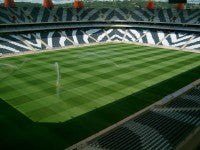 Having been in and out of South Africa a number of times to monitor the construction and grow in of the English FA site in Rustenburg (pre-Christmas 2009), I did, as did the rest of the world, wonder if the South Africans would achieve in delivering the required 100+ pitches across the stadia, venue specific training sites (VSPS) and team base camps in time.
Having been in and out of South Africa a number of times to monitor the construction and grow in of the English FA site in Rustenburg (pre-Christmas 2009), I did, as did the rest of the world, wonder if the South Africans would achieve in delivering the required 100+ pitches across the stadia, venue specific training sites (VSPS) and team base camps in time.
The previous August I had been asked by the FIFA local organising committee to do a 'whistle stop tour' of the stadia pitches only (14 flights + 10 venues in 5 days) and had submitted my recommendations report. I was, however, resigned to the fact that STRI's involvement with the 2010 FIFA World Cup South Africa was going to be solely with the English FA site at Rustenburg and to be honest I was content with that. The call to come back and review the stadium pitches for a second time came in January, except this time it also encompassed the venue specific sites.
It sounds romantic flying around such a beautiful country, but the romance wears off quick; there were a lot of problems with these pitches, particularly the stadium pitches which at the time were unlikely to meet the desired standard. Many myths surround the world cup like unlimited budgets, unlimited time, machinery, staff etc. This isn't the case. The stadia are delivered by the municipalities or councils under contract. These are not wealthy local authorities and those of us who deal with local authorities on a regular basis know the challenges. It's the people's money, it's taxpayer's money and anything spent is scrutinised and rightly so.
Interest in turf from the top brass
On the second trip, reviewing the stadia in late February, I couldn't help but be impressed by what had been achieved in South Africa in terms of stadium infrastructure on the trip. With the stadia built, or nearly built, the focus from the top brass of FIFA turned to the pitches. I was particularly impressed that the Secretary General of FIFA, who has an itinerary similar to a president, together with the South African Minister for Sport cleared their diaries and arranged to visit each of the pitches with myself and other technical staff to review and understand the challenges. The first issue was the conversion of the native Kikuyu grass to a predominant Ryegrass sward, or at least a dual sward.
The Kikuyu goes into dormancy in the winter months (World Cup time in South Africa) and doesn't perform well in shaded stadia or the cold with the aesthetics poor at this time of year. It is, however, a great grass for rugby and high-use, low-maintenance pitches. I am convinced that if the tournament was held in summer time, continuous management and refinement of this grass could have produced great pitches.

|
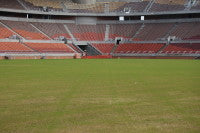
|
Pictures above show the seeding and growing in of the Peter Mokaba Stadium
However, considering that we couldn't change the seasons, a joint decision between the South African contractors, STRI and the pitch monitoring team was m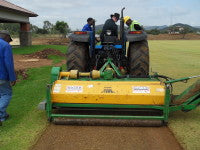 ade that the FIFA 2010 World Cup South Africa would be played on Ryegrass. Ryegrass was chosen for its shade tolerance, in comparison to other species, but also its durability, wear and aesthetics. Incidentally, on the advice provided in August 2009, the Cape Town Stadium had seeded a pure Rye pitch from day 1, which survived the summer relatively stress free, as did Mbombela and Polokwane in highs of 38 degrees. Perhaps the ability of Ryegrass to perform in warm temperatures with good management is underestimated?
ade that the FIFA 2010 World Cup South Africa would be played on Ryegrass. Ryegrass was chosen for its shade tolerance, in comparison to other species, but also its durability, wear and aesthetics. Incidentally, on the advice provided in August 2009, the Cape Town Stadium had seeded a pure Rye pitch from day 1, which survived the summer relatively stress free, as did Mbombela and Polokwane in highs of 38 degrees. Perhaps the ability of Ryegrass to perform in warm temperatures with good management is underestimated?
One key issue is that the conversion from Kikuyu to Rye needs to take place at the correct time; too early and the warm season grass bounces back with a mottled poa-like effect on the pitch; too late and the ryegrass doesn't establish enough. The other consideration was fixtures, which the majority of venues already committed, and the availability of machinery and contractors to do the work.
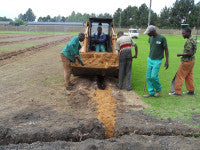 There is a huge geographical spread between the venues and considering that renovations were going on at the same time as the team base camp constructions, this posed its own issues. The World Cup had a series of ramp-up events to test the stadium systems and many of these events were rugby matches, a challenge for turf in itself. Rugby is massive in South Africa, similar in status to football in the UK; hence many of the pitches had to be Kikuyu-based until the end of the rugby season (early-mid April).
There is a huge geographical spread between the venues and considering that renovations were going on at the same time as the team base camp constructions, this posed its own issues. The World Cup had a series of ramp-up events to test the stadium systems and many of these events were rugby matches, a challenge for turf in itself. Rugby is massive in South Africa, similar in status to football in the UK; hence many of the pitches had to be Kikuyu-based until the end of the rugby season (early-mid April).
At this stage our warm season expert and project manager John Lockyer joined me in Johannesburg and took the reins in terms of renovating and managing these pitches through this change; supporting contractors, local consultants and managers on a daily basis. From the outset there was a great team effort from contractors and consultants and it really showcased the South African pride in their country and their ability to prove to the world their suitability to host such a tournament. Arranging another Koro Field Top Maker to be imported at this time helped a lot with the timeline of renovations.
For just a few hours on the English FA site in Rustenburg, I operated the Koro and tractor on the A and B pitches. For those few hours I was back to being a machinery operator again, no bad place to be; the worries of the world cup pitches lifted and my only worry, to keep a straight line with the tractor. With John's focus on the stadium pitch renovations another problem was looming up near the Kruger National Park at C Stadium.
The Mbombela pitch
The climate around Nelspruit in summer time is particularly hot with highs of 40+ degrees being achieved. The Kruger National Park is also just up the road, but in summertime I was paranoid about Malaria, hence the idea of a game drive was 'off limits'. By February 2010 the pitch at Mbombela had been replaced twice for various genuine reasons; with the client, contractor, local council and mayor at their wits end.
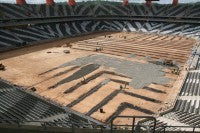
|
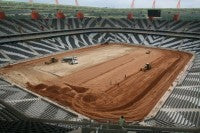
|
Pictures above show the drainage and pitch stabilisation processes at the Mbombela Stadium
It so happened that the most recent pitch removal coincided with a press roadshow by FIFA, which I was invited to with the theme of 'South Africa is ready', allowing 200 journalists access to the stadia for worldwide media coverage. On arrival on Saturday night, I was confronted with a huge pile of rootzone placed in the centre of the pitch, with pieces of turf being removed around the edges of the pitch.
The concern now moved to how this would look to an international press the following morning. Sitting down with the contractor and the client there was general dismay at the pitch problems with a necessity to get it right, with 'third time lucky' at the forefront of everyone's mind. We turned on the floodlights and worked through the night removing the old rootzone, spreading the new and grading the pitch.
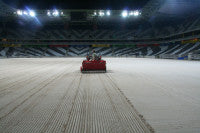
|

|
Pictures above show the seeding and growing in of the Mbombela pitch
As I had done a week earlier, I took position of excavator operator and grader and with the contractor, the client and the stadium director began mucking in to get the job done. By 5.30am, the pitch was levelled, graded and looked ready for seed. That morning everyone from the rakers to the truck drivers were proud of what we achieved and as the press arrived, it didn't look such a disaster.
A press conference was held the next morning where much scepticism was voiced on how the pitch project had been handled. I promised "in 2 weeks it will be green, in 4 weeks we will install synthetic reinforcement, in 6 weeks we will have our first game and in 8 weeks we will have the World Cup games playing on the best pitch of the tournament". I did think afterwards this statement could haunt me for the rest of my career and considered how humiliated I would be if things didn't go to plan.
To minimise the risk, Dale Frith, ex Blackburn and Wimbledon groundsman and STRI consultant came on to site to take over the grow-in, while Liverpudlian, Phil Luxon, arrived as groundsman and got to grips with the job. Remarkably the pitch was green in 5 days and made the headline news in the South African Newspapers. Amazing what 40 degree heat, a good groundsman and water can do!
Team base camps
With 60 days to go it felt like every corner we were turning we were running into problems. From machinery importation to training, through to chemicals and staffing levels. It was the wettest April on record in South Africa and monsoons had hindered construction and development of the 32 team base camps and we were asked to begin to project manage the delivery of these.

|
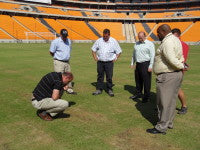
|
Pictures above show John Lockyer STRI carrying out performance testing at the Soccer City Stadium
With STRI busy with domestic and other international work we called in the steady hands of my old boss and mentor Aidan O Hara and also, from STRI, Steve Baker, Ian McClements and Andy Cole. Monitoring and project managing so many pitch builds over a huge geographical area was exhausting with starts at 5.30am and finishing at 10.00pm at the earliest.
The team was joined by 5 more technicians, putting in an average of 15,000 km per jeep over the 2 month period; I'm just hoping the rental company won't notice! During this period the equipment importation and logistics also had to be organised with a combination of Dennis, Toro, Redexim and Protea machines used.
A training day was organised for groundsmen in a "train the trainer" fashion in May, which involved input from contractors, consultants, STRI and machinery suppliers. At this stage, the interest in straight lines, groundsmanship and the pitches was massive, with a competitive element becoming evident between the venues. STRI and FIFA developed a scoring system which rates the surface from '1' being the best/perfect to '4' being unsuitable.
The talk over the bar that night was how many '1s' each contractor and groundsman had achieved. The scoring system was an excellent way of encouraging improvement, but also aided monitoring and reporting over so many sites. By the time the first teams arrived, most of the training camps, VSTS and stadia pitches had scored very well.
The big day arrives
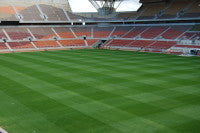 The amount of planning that goes into scheduling, timing etc for each match is phenomenal, with the pitches needing to be handed over 5 hours before kickoff. That means that if you have a 1.30pm kickoff, the pitch has to be handed over, cut and marked, the lot, by 7.00am; meaning in some cases a 3.00am start. And the next game or training session can be just 2 days after the initial game so the schedule is gruelling.
The amount of planning that goes into scheduling, timing etc for each match is phenomenal, with the pitches needing to be handed over 5 hours before kickoff. That means that if you have a 1.30pm kickoff, the pitch has to be handed over, cut and marked, the lot, by 7.00am; meaning in some cases a 3.00am start. And the next game or training session can be just 2 days after the initial game so the schedule is gruelling.
Performance testing is done on each of the pitches on the lead up to the event for traction, moisture, rooting depth, infiltration, ball bounce, hardness, height of cut and density. Decisions on pitch watering pre-game also have to be made as does preparations for pitch clean up post game. At this stage, permanent or contracted groundsmen have been installed on each site and are well familiar with the operation, with STRI performing a pitch monitoring and decision support service.
Weather
The weather has been unseasonably cold in South Africa with conditions representing London in February. Although pitch covering was used on some venues to battle against frost and hailstones, fixtures, training and necessary maintenance meant some frost damage to the kikuyu base and even some ryegrass suffered.
Some lighter coloured areas on pitches have been noted and recovery on the likes of goalmouths has been slow. Interestingly, the training sessions are very competitive and not a simple warm up. Drill training is common, as is major footwork. Hence, some venues were 'off limits' for training and moved to full non-restricted training sessions on the venue specific training sites, built specifically for this purpose.
The silver lining to this is the 'world cup buzz' the training sessions created in many of the townships and disadvantaged areas where the world's most famous teams practiced, at community based VSPS, for a day in June. The schools closed, the roads were off limits and the tiny stadiums that are the backbone of the Professional Soccer League in South Africa were for a day the most important venue in the World Cup.
The rain and cold weather at Port Elizabeth pushed a delicate pitch in the wrong direction for the first few games which has struggled to recover to an optimum condition since. The groundstaff have worked day and night to divot and improve the surface which has achieved an improvement in stability, but reduction in aesthetics. Built in early 2009 a plan is already underway to improve the pitch for the longer term.
Although the stadium itself is spectacular the micro environment created has meant turf strength is less than desired. It will see the tournament through and it is improving in terms of performance on a match-by-match basis.
It would be nice to have no pitch problems, but when you take on a project like this with the timelines involved, when problems do crop up, you just have to manage it as best you can and support and encourage the groundstaff and groundsman on what can be a glory-less task.
As the knock out stages finish and we approach the quarter finals, semi finals and final, I am sure we will have more challenges. However, I am confident that with the team of native South African groundstaff and superb contractors we will see it through. To date, I feel proud of our own role and team effort from STRI on the project (some staff have not been home for 3 months!) but I am also proud of what the South African Sports turf industry has done in showing the world what is achievable with team work and effort. Hopefully my report at the end of the World Cup will be as positive!
